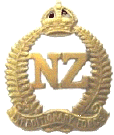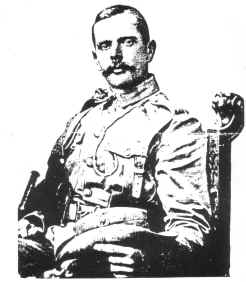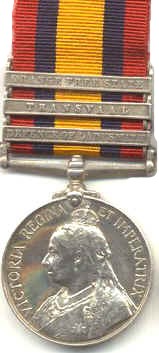|

|
| Category: Boer War |

|
|
|
|
|
|
NEW ZEALAND'S FIRST OVERSEAS
CASUALTY |
| The death of trooper
G.R. Bradford by Richard Stowers. |
|

G.R. Bradford, Killed in Action, 19-12-1901 |
Jasfontein farm, located in northern Cape Colony, South Africa, probably has no significance to New Zealanders at large, yet it was the scene of the first serious
overseas engagement in which our troops fought against an enemy. It was also the place where the first New Zealand soldier was shot while on active service.
The first New Zealand Mounted Rifles landed at Cape Town about the middle of November 1899, and were immediately entrained to join General French's troops operating in the Colesburg district of northern Cape Colony.
It was not long before some members of the contingent came under Boer rifle fire, but it was all at long range and little more than intermittent sniping. |
On the 18th December 1899, General French wished to ascertain the Boer position at Taaiboschaagte, and early in the morning a number of troops, including the New Zealanders, rode to Jasfontein farm. The terrain consisted of the farm house
(becoming French's command post), and a large shed on a plain, which extended for some distance towards a range of kopjes. At the foot of the first kopje there was a large dry watercourse (donga), which separated the level plain from the hilly country. Lieutenant
Lindsay's Division of No. I Company was detailed to ascertain whether these kopjes were occupied by the enemy.
They rode across the plain, crossed the donga, and rode up the lower slopes of the kopje until the ground became too rough for the horses. Once they had dismounted, these were left in charge of the number threes of each section while the men scrambled to the top. The first kopje was not occupied by the Boers but the higher ones at the rear certainly were and they directed a heavy fire of
Mauser bullets on the New Zealanders who were extended below.
One trooper, No.46 John (Jack) Tetley was at this time lying close to trooper No.44 George Bradford. John stated later that George was getting his shots in pretty rapidly (from his issued Martini Enfield .303 rifle), when he stopped, laid down his carbine, and keeping his head a little from the ground, looked straight at the Boer position for several minutes without moving, as if having some premonition that this was to be his last day. After looking for a while he laid his head on the ground, and as he did not move, Jack Tetley called to him, thinking he had been shot. However, after replying to Jack's enquiry, George continued his firing until the order came to retire.
The horses of Lindsay's Division were down under cover in the donga, but they were easily picked up by the Boer gunners with their Long Tom on Taaiboschlaagte. It was not long before their 15 pound shells were landing in the vicinity of the donga. The first round burst ten yards beyond the horses, making the position of the holders nearly impossible.
General French gave orders for the troopers to withdraw, so Colonel Robin (The New Zealanders' commanding officer) sent No. I 11 Bugler Fred Fox with orders for Lindsay's Division to retire. This was the third time that Fred had been up to Lieutenant Lindsay's position. On his first mission he noticed No.7 Sergeant William Mahood endeavouring to break down a strong wire fence near the donga. He rode straight back to the farmhouse, obtained a pair of
wire cutters and returned. Fred rode up the third time with Colonel Robin's order, safely delivered it, and returned under a heavy rain of fire.
When the order reached Lieutenant Lindsay, the men came down singly off the
kopje. They mounted their horses and galloped through the cut fence and across the broken ground to the farmhouse, a distance of about 800 yards, under heavy rifle fire. It was at the broken ground, just past the donga, that George Bradford received a
bullet wound, above the hip on his left side, and in failing from his horse, landed on his head. He came to rest lying doubled up and face downwards, to all appearances dead.
Bradford's horse, which was wounded in six places, galloped off past the farmhouse, pursued by No. 15 Bugler Thomas Brown, but rescued by No.28 Trooper William Parkes (who had his horse shot dead). The latter mounted Bradford's horse and galloped to the rear.
There was little said on the march through the long rows of kopjes to Arundel, which was reached at midday. Every man present had noticed the ambulance, containing six men under the Red Cross, which left camp that afternoon to bury poor
Bradford.
It was later stated by Veld-Cornet K. Van Wijk that he, with other Boers, found two badly wounded men, one a Tenth Hussar, and the other a New Zealander. He sent back to camp for some rugs, for as he was a 'Horse Commando' the ambulance was some distance away, and the wounded men were placed therein and carried into the camp. The Hussar conversed freely, but the New Zealander was in great agony, having been shot in the groin, and did not speak. The wounded men were carried to a building some two miles away, at a place called Rensburg Siding which served as a field hospital.
The Hussar, named Scott, died that same night but the New Zealander lived for
about a week. The Veld-Cornet indicated that he spoke with Bradford, who told him that he was suffering great agony. This is in conflict with the official New Zealand report which states that Bradford never recovered consciousness. Mortification set in, and when asked whether he had any special request to make, Bradford shook his head. He was buried at Rensburg Siding on the Naauwpoort-Colesburg line.
It was not until 30th December 1899 that the New Zealanders learned of the death,
when his grave was discovered by the Carabinier patrols. One of Colonel Porter's orderlies brought the news to Colonel Robin that afternoon.
No.44 Trooper George Roland Bradford was the son of Mr. F. Bradford, of The Red
Lion Inn, Brede, Sussex, England. Having been a private in the Grenadier Guards, he
traveled to New Zealand in 1895, and joined the Ohinemuri Rifles as Battalion
Sergeant Major. His occupation was listed as laborer. Wounded at Jasfontein farm 18th December 1899 and dying on 28th December 1899, he
was buried close to a stone wall. The grave was marked by a wooden cross, engraved:

|
- Gone, but not forgotten,
- Never will his memory fade
- Noble thoughts will always
linger
- Where our comrade brave is
laid.
He was aged 29 years at his death, and his comrades thought him to be
under-ranked. The body was disinterred and reburied at Colesburg, being marked to this day by an iron cross.
A memorial was erected on Primrose Hill, Paeroa at a cost of 63 pound 8 shillings and 2 pence. It was unveiled by the Premier on 4th May 1903. His bandolier was used as the Badge of Office of the Dominion President of the South Africa War Veterans Association of New Zealand. Each silvered bullet was engraved with a President's name.
Bradford received the Queen's South African medal with the 'Cape Colony' bar. |
|
|
from the Journal of the NZ
Military Historical Society June 1984 |
|